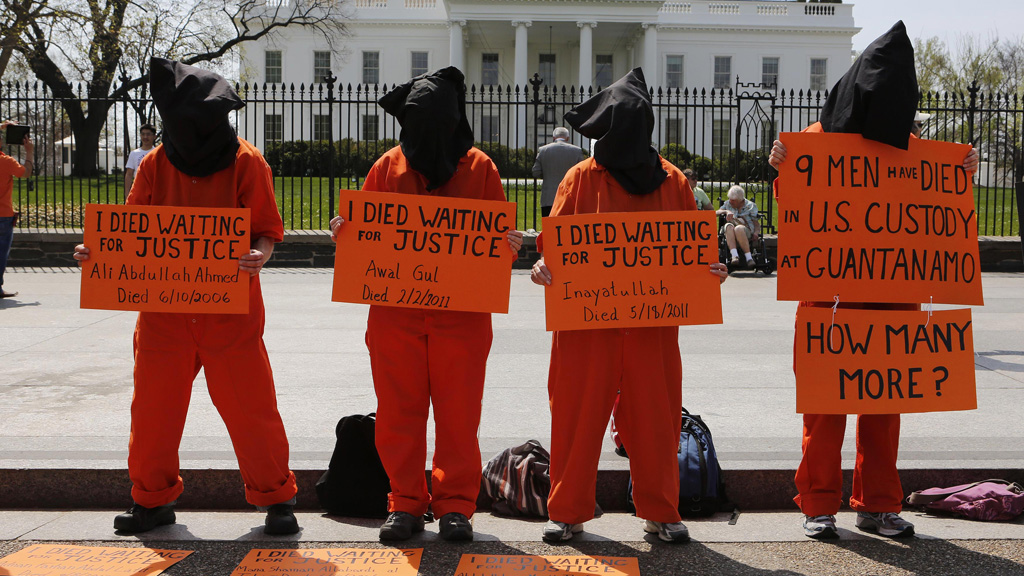Guantanamo Bay: violence, hunger strikes and protests
Violent clashes, hunger strikes and growing calls for its closure – what is happening in Guantanamo Bay, three years after its promised closure?
At the weekend, following months of increased tensions at the Cuban prison camp, detainees attacked their guards with makeshift weapons. The guards responded by firing four “less than lethal” rounds at the prisoners.
Guards moved into a communal section of the prison at 5am in the morning, after detainees had covered up security cameras and windows.
Guards entered the communal area, which is used as a reward for prisoners who behave themselves, to move inmates into single cells – but were met by a violent backlash from prisoners who had armed themselves with a range of weapons including broomsticks and mop handles.
I had never experienced such pain before. I would not wish this cruel punishment upon anyone. Samir Maji al Hasan Moqbel, hunger striker.
Military spokesmen said there were no serious injuries from officers firing riot control weapons, such as rubber pellets, at prisoners.
Detainees were being housed in single cells so they could be “observed more closely”, the spokesman said, adding that one of the concerns was that prisoners were being coerced into hunger striking.
Force-fed
The clash occurred as a result of tensions at the facility. A hunger strike was started on 6 February, and lawyers representing some of the prisoners said that the majority of inmates are now involved. The military says that 43 detainees are classified as hunger strikers, meaning they have missed nine consecutive meals. Eleven are being force fed, the military said.
Writing in the New York Times, Samir Maji al Hasan Moqbel, a Yemeni detainee at the prison, described the force feeding process.
“I will never forget the first time they passed the feeding tube up my nose,” he wrote. “I can’t describe how painful it is to be force-fed this way. As it was thrust in, it made me feel like throwing up. I wanted to vomit, but I couldn’t.
“There was agony in my chest, throat and stomach. I had never experienced such pain before. I would not wish this cruel punishment upon anyone.
“I am still being force-fed. Two times a day they tie me to a chair in my cell. My arms, legs and head are strapped down. I never know when they will come. Sometimes they come during the night, as late as 11 pm, when I’m sleeping.”
Cleared for release
Tensions have arisen from the fact that 87 of the detainees were cleared for release by a government taskforce in 2011. Around 50 occupy a legal limbo, whereby they are deemed too dangerous to release, but there is also not enough evidence to prosecute them.
The UK seems to just accept routine assurances from the US that all is well, when in fact all is rotten in Guantanamo Bay. Clive Stafford Smith, Reprieve
Three of the 166 detainees have been convicted and a further 30 are waiting to face trial. Among the detainees at the prison are 16 “high value” prisoners, including senior members of al-Qaeda.

The most high-profile of all is Khalid Shaikh Mohammed (pictured, above). The Pakistani national, who has been held for six years and seven months, allegedly masterminded the 11 September 2001 terrorist attacks on the World Trade Centre and the Pentagon.
Last year pre-trial hearings took place ahead of his trial, in which the death sentence is being sought.
Also involved in the hunger strikes is the last British resident in Guantanamo, Shaker Aamer, who has been detained for more than 11 years. A government e-petition to have him returned to the UK now has more than 100,000 signatures, meaning it will be considered for debate in the House of Commons.
Clive Stafford Smith, Mr Aamer’s lawyer and a director at charity Reprive, said: “The UK seems to just accept routine assurances from the US that all is well, when in fact all is rotten in Guantanamo Bay.
“Why does the UK take the position that there is nothing more that can be done when a close ally is committing the on-going torture of Shaker Aamer?”
US ‘undermined’
The US is facing growing calls for the closure of Guantanamo Bay. In January 2009 Barack Obama signed an order that the prison facility should be closed within a year. Since then, the detainee population has fallen by 76, around 30 per cent, but it remains open.
This raises serious concerns under international law. It severely undermines the United States’ stance that it is an upholder of human rights. Navi Pillay, UN human rights commissioner
At the start of April, Navi Pillay, the UN high commissioner for human rights, said: “I am deeply disappointed that the US government has not been able to close Guantanamo Bay, despite repeatedly committing itself to do so.
“Allegedly, around half of the 166 detainees still being held in detention have been cleared for transfer to either home countries or third countries for resettlement. Yet they remain in detention at Guantanamo Bay.

“Others reportedly have been designated for further indefinite detention. Some of them have been festering in this detention centre for more than a decade.
“This raises serious concerns under international law. It severely undermines the United States’ stance that it is an upholder of human rights, and weakens its position when addressing human rights violations elsewhere.”
Rights groups have also called for the detention centre’s closure, and on Thursday an open letter was sent from 25 organisations, including Amnesty International and Human Rights Watch, saying the current situation is “the predictable result of continuing to hold prisoners, indefinitely, without charge for more than 11 years.”
Protesters also gathered outside the White House to demonstrate against the continuing existance of the facility (pictured, above).